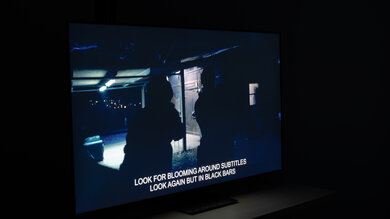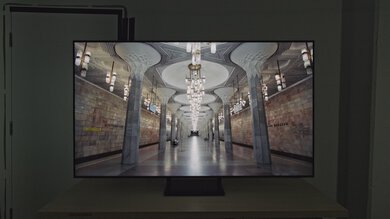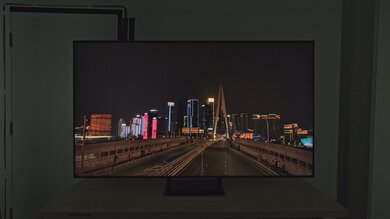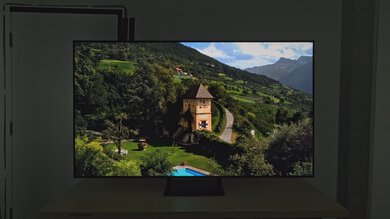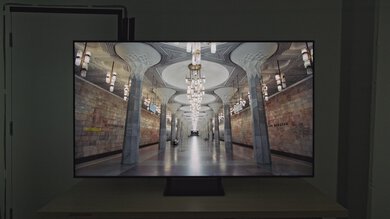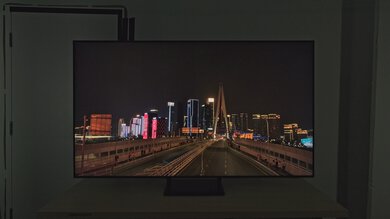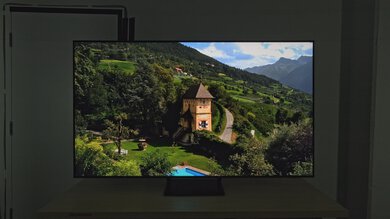The Samsung Q70D QLED is the mid-range option in Samsung's 2024 QLED lineup and replaces the Samsung Q70C QLED. It sits between the lower-end Samsung Q60D QLED and the higher-end Samsung Q80D QLED. Like its predecessor, it's a 120Hz model and has modern gaming features like HDMI 2.1 bandwidth on all four ports, 4k @ 120Hz, and VRR support. The TV doesn't have a local dimming feature to improve contrast. Although it supports Samsung's HDR10+, it doesn't support Dolby Vision or DTS audio formats. It does feature Samsung's Multi View feature that allows for two sources to be displayed on the screen at the same time and has other features like voice control. The TV runs the 2024 version of Samsung's Tizen OS and has a built-in 20W 2.0 channel speaker system. We bought and tested the 65-inch model, but it's also available in 55, 75, and 85-inch sizes.
Our Verdict
The Samsung Q70D is decent for mixed usage. It gets bright enough in SDR and has good enough reflection handling to use in a bright room, but its limited contrast ratio really limits its impact on the viewer in a dark room and holds back its HDR performance. Fortunately, it's a very good gaming TV due to its modern gaming features. On the other hand, its very narrow viewing angle makes it a poor choice for watching TV with a group of friends.
- Impressive SDR brightness.
- HDMI 2.1 bandwidth, 4k @ 120Hz, and VRR support.
- Narrow viewing angle leads to a degraded image when viewed from the sides.
- No local dimming to improve contrast.
- Struggles with reflections from direct light sources.
The Samsung Q70D is decent for watching TV shows. It has impressive SDR brightness and satisfactory reflection handling, so you can use it in a well-lit room and won't be overly distracted by reflections on your screen. The TV does a good job upscaling low-resolution content, but its low-quality content smoothing is only alright, so you do see artifacts in low-bitrate content. Finding shows to watch is fast and easy, thanks to the built-in Tizen OS. Unfortunately, its image quality degrades when viewed from the sides due to its very narrow viewing angle, so it's not a good choice for watching shows with a group of friends.
- Very good pre-calibration SDR color accuracy.
- Impressive SDR brightness.
- Good upscaling capabilities.
- Narrow viewing angle leads to a degraded image when viewed from the sides.
- Struggles with reflections from direct light sources.
The Samsung Q70D is decent for watching sports. It overcomes glare due to its impressive SDR brightness and satisfactory reflection handling, so it's suitable for watching NFL games on a bright Sunday afternoon. On the other hand, its very narrow viewing angle means the image degrades when viewed from the sides of the screen, making it a poor option for watching the game with a group of friends. The TV has only decent gray uniformity with noticeable dirty screen effect, which is a bit distracting when watching sports like hockey that have large areas of uniform color. Its response time is satisfactory, but you do see some blur behind fast-moving players and objects.
- Impressive SDR brightness.
- Good upscaling capabilities.
- Narrow viewing angle leads to a degraded image when viewed from the sides.
- Only decent gray uniformity with noticeable dirty screen effect.
- Struggles with reflections from direct light sources.
The Samsung Q70D is very good for playing video games. It has incredibly low input lag for a responsive feel, but its response time is only satisfactory, so you do see some blur behind fast motion. The TV has HDMI 2.1 bandwidth on four ports for 4k @ 120Hz gaming with VRR, so it pairs excellently with modern consoles. There's no effect on image quality when the TV is set to Game Mode, so you can enjoy the best possible image while also getting the best possible performance out of the TV. It's also bright enough in SDR, and you can use it in a room with some lights on and not be distracted by reflections on the screen.
- Very good pre-calibration SDR color accuracy.
- Impressive SDR brightness.
- HDMI 2.1 bandwidth, 4k @ 120Hz, and VRR support.
- Incredibly low input lag.
- Only satisfactory response time means fast motion has noticeable blur behind it.
- Struggles with reflections from direct light sources.
The Samsung Q70D is just alright for watching movies in a dark room. Unfortunately, the TV is held back by its only adequate contrast, so blacks are pretty deep in dark scenes, but they become raised and grayish when bright highlights are also on-screen since it lacks local dimming. Despite having good HDR brightness, highlights don't stand out too much due to its limited contrast. The TV does a good job upscaling low-resolution content, but its only okay low-quality content smoothing means you still see artifacts in low-bitrate content, like DVDs. Its pre-calibration SDR accuracy is very good, so colors in SDR are accurate without needing calibration. Sadly, the TV only removes judder from the internal apps, so movies watched from any other source have noticeable judder.
- Very good pre-calibration SDR color accuracy.
- Wide color gamut for vibrant colors.
- Good upscaling capabilities.
- Doesn't remove 24p judder from external sources.
- No local dimming to improve contrast.
- No Dolby Vision or DTS audio support.
The Samsung Q70D is very good for playing games in HDR. It has good HDR brightness, meaning some highlights stand out in games, but due to its only adequate contrast, HDR games still lack impact. Fortunately, there's no decrease in HDR brightness when set to Game Mode, so you can get the best possible performance without having to see a dimmer image. It has HDMI 2.1 bandwidth on all four ports, 4k @ 120Hz, and VRR support, so it pairs well with modern consoles. Fast motion has some noticeable blur behind it due to the TV's satisfactory response time. However, it has incredibly low input lag, so gaming feels responsive.
- Wide color gamut for vibrant colors.
- HDMI 2.1 bandwidth, 4k @ 120Hz, and VRR support.
- Incredibly low input lag.
- No local dimming to improve contrast.
- Only satisfactory response time means fast motion has noticeable blur behind it.
- Struggles with reflections from direct light sources.
The Samsung Q70D is very good for use as a PC monitor. It has impressive SDR brightness and satisfactory reflection handling, so it overcomes glare in a bright room. Its response time is only satisfactory, so you do see some blur behind fast cursor movements. However, it has incredibly low input lag, meaning you get a responsive desktop experience. Unfortunately, it has a narrow viewing angle, meaning the sides of the screen aren't uniform with the center when sitting up close. The TV displays chroma 4:4:4 properly, but the TV uses a BGR subpixel layout that impacts the text clarity, although not everyone will be bothered by this.
- Impressive SDR brightness.
- Wide color gamut for vibrant colors.
- Incredibly low input lag.
- Chroma 4:4:4 works properly.
- Narrow viewing angle leads to a degraded image when viewed from the sides.
- Only satisfactory response time means fast motion has noticeable blur behind it.
- Struggles with reflections from direct light sources.
Changelog
- Updated Nov 12, 2024:
Mentioned the newly-reviewed LG QNED85T in the Response Time section.
- Updated Oct 04, 2024: We mentioned the newly-reviewed Samsung Q80D QLED in the Contrast section of this review.
- Updated Oct 03, 2024: Updated the information on panel technology in the Pixels section of this review.
- Updated Sep 24, 2024: Review published.
Check Price
Differences Between Sizes And Variants
We've bought and tested the 65-inch Samsung Q70D, which is also available in 55, 75, and 85-inch sizes. All sizes offer the same picture quality and overall performance. Note that with Samsung TVs, the five letters after the short model code (AFXZA in this case) vary between different retailers and regions, but there's no difference in performance.
Costco and Sam's Club sell a variant of this TV known as the Samsung Q72D. This variant performs the same but comes with an extended warranty and other store-specific perks.
| Size | US Model | Warehouse Model (US) |
|---|---|---|
| 55" | QN55Q70DAFXZA | QN55Q72DDFXZA |
| 65" | QN65Q70DAFXZA | QN65Q72DDFXZA |
| 75" | QN75Q70DAFXZA | QN75Q72DDFXZA |
| 85" | QN85Q70DAFXZA | QN85Q72DDFXZA |
Our unit was manufactured in March 2024, as seen on the label.
Popular TV Comparisons
The Samsung Q70D is a decent TV overall, but it's really held back by its lack of a local dimming feature. It's also very overpriced for what it does, and it doesn't do anything special that makes it stand out in the sea of mid-range QLEDs. You're much better off saving some money and going with TVs like the Hisense U7N or the TCL QM7/QM751G QLED, as those models are brighter, support 144Hz, display a wider range of colors with less banding, support Dolby Vision and DTS audio formats, and have effective local dimming features to drastically increase their black levels.
For more options, check out our recommendations for the best TVs under $1,000, the best QLED TVs, and the best TVs for gaming.
The Samsung Q80D is better than the Samsung Q70D, as it offers a noticeable upgrade in every way. The Q80D has a local dimming feature, giving it way better contrast than the Q70D. The Q80D is also brighter in HDR and SDR, and has better color volume, so all content is more impactful on that model.
The Samsung Q70D is better than the Samsung Q60D in most ways. The Q70D gets brighter in SDR, so it fights more glare in a well-lit room. The Q70D also gets brighter in HDR and has better PQ EOTF tracking, so it delivers a more impactful and accurate HDR experience. The Q70D is the better gaming TV, as it has HDMI 2.1 bandwidth, 4k @ 120Hz, and VRR; it pairs much better with modern consoles. However, the Q60D has better contrast, so its blacks are deeper in a dark room.
The LG QNED85 is better than the Samsung Q70D QLED. While they're closely matched in many respects, the LG delivers much deeper blacks thanks to its local-dimming solution, as well as a wider viewing angle and slightly faster response time. The Samsung is a bit brighter, but that doesn't quite offset the LG's contrast advantage.
The Samsung Q70D is a bit better than the 2023 Samsung Q70C. The Q70D is brighter overall, so it overcomes more glare in a bright room and displays brighter highlights in HDR content. It also has a slightly better contrast ratio for deeper blacks during dark scenes and is the more accurate TV.
Test Results

The Samsung 65Q72D has the same design as last year's Samsung Q70C QLED, with a clean and simple look.
The back of the TV is plastic with fine horizontal etchings, and it feels solid overall, without excessive flex around the VESA holes or inputs. There are grooves on the back of the TV and the stand for cable management. Unfortunately, the inputs are recessed into the TV, so they're hard to reach if you wall-mount it with a fixed bracket.
The Samsung 65Q72D has good build quality. The TV has an all-plastic build that makes it feel a bit cheap, but it still feels pretty solid overall. The stand holds the TV well, and there's minimal wobbling when pushing or moving the TV. There are no major flaws with build quality and no issues with quality control.
The Samsung Q72D has adequate contrast. Its native contrast ratio is good enough that blacks are somewhat deep during purely dark scenes, but since it lacks local dimming, blacks become raised and grayish when brighter highlights are also on screen. If you'd like better contrast than this model offers, look up the higher-end Samsung Q80D QLED.
This TV doesn't have a local dimming feature, so it doesn't adjust the backlight of individual areas to brighten up highlights without impacting the rest of the image. This means that there are no distracting flickers or brightness changes as bright highlights move across the screen.
The Samsung Q72D has good HDR brightness. Unfortunately, the TV doesn't provide a very good HDR experience since its contrast isn't good enough to have brighter highlights stand out very much against a darker background.
These measurements are after calibrating the HDR white point with the following settings:
- HDR Picture Mode: Filmmaker
- Brightness: 50
- Contrast: 50
- Color: 25
- HDR Tone Mapping: Static
- Color Tone: Warm 2
- Color Space: Auto
- Gamma: ST.2084 (0)
Results with 'HDR Tone Mapping' set to 'Active':
- Hallway Lights: 503 cd/m²
- Yellow Skyscraper: 403 cd/m²
- Landscape Pool: 194 cd/m²
The Samsung Q72D is slightly brighter in Game Mode, but it's less accurate.
These measurements are after calibrating the HDR white point, with the following settings:
- HDR Picture Mode: Game
- Brightness: 50
- Contrast: 50
- Color: 25
- HDR Tone Mapping: Static
- Color Tone: Warm 2
- Color Space: Auto
- Gamma: ST.2084 (0)
- Game HDR: Basic
- HDR10+ Gaming: Basic
Results with HDR Tone Mapping set to 'Active':
- Hallway Lights: 507 cd/m²
- Yellow Skyscraper: 481 cd/m²
- Landscape Pool: 253 cd/m²
The TV has excellent PQ EOTF tracking, but it's not perfect. Blacks are displayed a bit brighter than intended, while mid-tones and highlights are displayed a bit darker than intended. Other than that, the TV follows the curve closely until there's a roll-off near the TV's peak brightness to maintain details in highlights. With content mastered at 4000 nits, the roll-off is even more gradual.
The TV has impressive SDR brightness and is bright enough to overcome glare in a well-lit room.
These measurements are after calibration with the following settings:
- Picture Mode: Movie
- Brightness: 50
- Contrast: 45
- Color: 25
- Color Tone: Warm 2
- Gamma: 2.2
The TV has a good color gamut. It has excellent coverage of the commonly used DCI-P3 color space, but all colors are undersaturated and/or inaccurate. The TV has okay coverage of the less common Rec.2020 color space, but all colors are even more undersaturated and off the mark.
The TV's color volume is decent. It doesn't display darker colors well due to its only adequate contrast, and it doesn't display vibrant colors very brightly.
The TV has very good pre-calibration SDR accuracy. Blues and greens are underrepresented in darker shades of gray, and reds are underrepresented in all grays. The color temperature is cooler than the 6500K we aim for, and the gamma is a bit off of 2.2, with most scenes being displayed darker than they should be. Color accuracy is very good overall, but saturated reds and magentas, lighter yellows, and whites do have some noticeable inaccuracies.
The TV has fantastic accuracy after calibration, and it's easy to calibrate. The color temperature is much closer to 6500K, and the white balance and gamma are now almost perfect. Color accuracy is better now, but there are still some minor inaccuracies with reds.
See our full calibration settings.
The Samsung Q72DD has decent gray uniformity. The sides of the screen are quite a bit darker than the middle, and there's noticeable dirty screen effect towards the center of the screen. On a very dark or near-black screen, its uniformity is very good, but the corners and the bottom edge are a bit brighter than the rest of the screen.
The Samsung Q72DD has an inadequate viewing angle, so it's not suitable for a wide seating arrangement. There's significant gamma shifting, black level rise, and brightness loss as you move off-center, and colors look increasingly washed out as you move further away to the sides.
The Samsung Q72D has satisfactory reflection handling. Its semi-gloss screen finish significantly reduces the intensity of indirect reflections, like when glare from a ceiling light isn't directly facing the screen. Unfortunately, the TV's handling of direct reflections is only alright, so reflections caused by something like a lamp positioned in front of the screen are distracting.
The TV has mediocre HDR gradient handling. There's some noticeable banding in almost all color gradients. Brighter reds fare better and have minimal banding.
The Samsung Q72D does a good job at upscaling low-resolution content like DVDs or lower-resolution streams. Details are clear enough, but finer details are hard to make out.
Sharpness processing was calibrated with no over-sharpening for low-resolution content with the following settings:
- Sharpness: 5
- Picture Clarity Settings: Off
The TV uses a BGR (Blue-Green-Red) subpixel layout instead of the traditional RGB layout. This doesn't cause any issues for video or gaming content, but it can be a problem for PC monitor use as it impacts the text clarity, although not everyone will notice this.
The TV uses quantum dot color converters to produce red and green light, which can be seen in the spectral power distribution (SPD) chart.
The Samsung Q72D has a satisfactory response time. Fast motion has noticeable blur behind it, and it's slower when coming out of dark states, so there's some black smearing in dark scene transitions. If you specifically want a TV with a faster response time, take a look at the LG QNED85T.
The TV uses pulse-width modulation (PWM) to dim its backlight, which introduces flicker that can bother people who are sensitive to it. The amount of flicker varies depending on what picture mode the TV is set to and what settings you're using.
It flickers at a very fast 960Hz in the 'Movie' picture mode at all brightness levels. In all other picture modes, it flickers at a slower 120Hz at all brightness levels. With 'LED Clear Motion' enabled, the TV flickers at 60Hz, and with the 'Picture Clarity' settings enabled, it flickers at 120Hz.
The TV supports backlight strobing, more commonly known as black frame insertion (BFI). The feature is designed to improve the appearance of motion by strobing its backlight and reducing the amount of persistence blur. The BFI feature on the TV only flickers at 60Hz, and there's still some minor image duplication present.
This TV has an optional motion interpolation feature to improve the clarity of motion, but it doesn't work very well. Even slower-moving scenes have some noticeable artifacts and haloing present. In faster-moving scenes, it can't keep up, and there are distracting artifacts and haloing, and sometimes the TV stops interpolating altogether.
Due to the TV's slower response time, there's very little noticeable stutter when watching 24p content.
The Samsung Q72D automatically removes judder from the native apps. Unfortunately, it doesn't remove judder from any external sources.
The Samsung Q72D is compatible with all three variable refresh rate (VRR) formats, and it works across a very wide refresh rate range, which ensures that your games remain nearly tear-free when gaming. It also supports sources with Low-Frame-Compensation (LFC), which ensures your games remain nearly tear-free even when your frame rate drops very low.
This TV has incredibly low input lag when set to Game Mode, which ensures a very responsive gaming experience with very little delay between your actions with your controller or mouse and the action on-screen.
The Samsung Q72D supports all common resolutions up to 4k @ 120Hz. It displays chroma 4:4:4 properly with any signal as long as the input label is set to PC, but sometimes 4:4:4 doesn't work properly, and the TV requires a power cycle. 1440p @ 120Hz @ 4:4:4 is not supported.
The TV is fully compatible with everything the PS5 offers, like 1440p @ 120Hz and 4k @ 120Hz, as well as HDMI Forum VRR. It also supports Auto Low Latency Mode, so you don't have to worry about manually switching to Game Mode to get the lowest input lag.
The TV is fully compatible with almost everything the Xbox Series X|S offers, including 1440p @ 120Hz, 4k @ 120Hz, HDMI Forum VRR, and FreeSync Premium Pro. It also supports Auto Low Latency Mode, so you don't have to worry about manually switching to Game Mode to get the lowest input lag. Unfortunately, Dolby Vision isn't supported on the TV, so gaming in Dolby Vision isn't possible.
Although the TV supports HDMI 2.1 bandwidth on all four HDMI ports, all four ports are limited to 40 Gbps. In practice, this doesn't cause any issues or limitations with any current source. Unfortunately, Samsung still doesn't support Dolby Vision. However, it supports HDR10+ instead, which is similar overall but not as widely supported.
The TV has eARC support, which allows it to pass uncompressed high-quality audio from a connected source to your home theater system or soundbar. Unfortunately, it doesn't support any DTS formats commonly used on Blu-rays.
The TV's frequency response is sub-par. Like most TVs, bass is pretty much non-existent. The sound is well-balanced at moderate listening levels, so the dialogue is clear, but it sounds progressively unbalanced as the volume increases. Since the TV doesn't get very loud, it's best suited for a quiet environment.
The TV's distortion performance is okay. There's some minor distortion at lower volume levels, and the amount of distortion increases as you raise the volume.
The Samsung Q72D Series has a great selection of apps, so it's easy to find your favorite content. You can also cast content from your phone onto the TV or play videos from a USB stick.
The TV comes with the same minimalistic remote as the 2023 Samsung Q70C QLED. The remote has a rechargeable battery that can be charged via USB-C or solar power. It has buttons for popular streaming services, and the voice control gives you access to Bixby and Alexa. You can ask it to change settings, switch inputs, and answer basic questions, but it can't search for content within apps.









